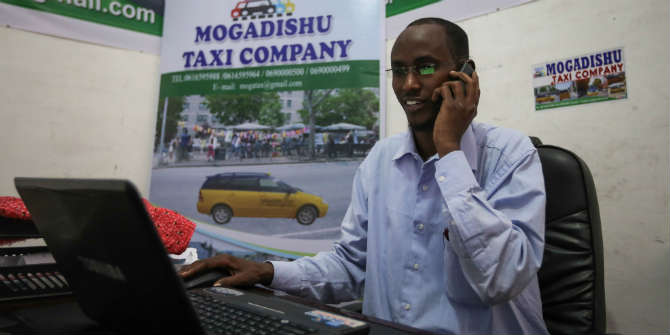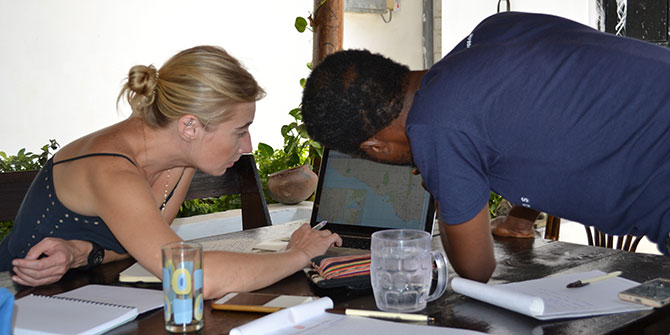Could the current modalities of humanitarian aid to refugees be improved? Dr. Stephanie Levy argues for more creative aid agreements to form the backbone of the global response to the current refugee crisis.
At the World Humanitarian Summit (WH Summit), David Miliband, head of the International Rescue Committee, announced that 25% all of all IRC interventions will be ‘cash based distributions’ by 2020, arguing that ‘cash transfers work both in empowering people and in driving local economic development’.
Newly pledged aid agreements should account for the economic impact of cash transfers
‘Just give them the money’ is an often quoted prescription by development economists working in the field of social protection and humanitarian crisis. It has been used quite intensively in the current debate on how to effectively support refugees during this recent wave of migration and conflict. In fact, the benefits of cash transfers (CTs) in humanitarian contexts are well documented and there seems to be a consensus emerging (Baily & Harvey 2015) in the current debate around the use of these interventions to provide immediate assistance to refugee populations, in refugee camps in particular. The WH Summit was a testament to the growing commitment by governments, NGOs and practitioners to support this form of aid delivery.
At the same time, unprecedented aid agreements with MENA hosting countries are being signed, promising substantial financial support, part of which is supposedly aimed at covering the refugee population’s subsistence needs. In February, nearly $12 billion of new aid was pledged at the Donor Conference in London to support Syrian refugees.

Image credit: World Bank Photo Collection, Dominic Chavez
This could be seen as good news for both refugees and their hosting countries. There are however important reasons to question the economic impact that both CTs and substantial aid flows could have on the economy of refugee hosting countries, and more particularly on the livelihoods of people living in and around the refugee camps. While we have little evidence on the potential impact of these flows on the economy around the refugee camps, existing research and economic lessons from past aid experience could be reviewed and analysed to offer concrete recommendations for an efficient use of these resources.
Aid, like oil, can distort local markets
A large body of evidence has been established for two decades around the distortions that large aid flows could generate. So called ‘Dutch Disease’ effects, involving increases in real exchange rates, domestic inflation and economic growth slowdown have been well documented and analysed by economists. So much so, that aid has been compared to oil (Collier, 2005) for its potential effects on domestic economies and prices. This is in addition to the political impact of worsening inequalities and increasing social fragmentation.
Similarly, the issue of cash transfer impacts on the local economy and on prices in particular, should be questioned (Levy 2015). In a study of the general equilibrium impact of social protection in Cambodia, Robinson and Levy (2014) found that the surge in demand for consumption by CT recipients could lead to an increase in prices when a) markets are remote and isolated and trade does not regulate price efficiently and b) there is insufficient supply elasticity and capacity to adjust to the increase in demand. Other studies have similarly provided evidence of the potential risks of local price increases resulting from the distribution of cash transfers. Such price effects have been found in Mexico for example, where the development of markets and productive sectors are expected to be more advanced and well able to respond to increases in household demand.
Furthermore, the arguments in favour of CTs as a stimulus for the local economy, i.e. using cash to solve credit market imperfections or promote local economy, do not apply in the context of refugee camps. Refugees are almost exclusively dependent on the cash they receive for survival. They are legally restricted from working in the hosting country, and risk losing their refugee status if they do. In practice however, refugees constitute a potentially cheaper labour force that is sometimes used informally, and often under appalling working conditions.
Accounting for local market’s capacity and regional trade
So research and existing evidence on both large aid flows and cash transfers led us to question the potential economic impact of the migrant crisis on hosting countries if aid agreements are kept in their current forms. It may be the case that the local capacity to absorb both large humanitarian aid flows and CTs is better among Middle East & North African (MENA) countries, compared to countries with less economic capacity, lower productivity and technology, less market integration and, especially, less dynamic trade. If so, concerns about inflation and economic slowdown might be seen as less relevant (Barder, 2015). But it may also not be the case that their economy and productive capacity is not as robust what is needed to absorb large economic shocks.
Given that humanitarian aid pledged to hosting countries is substantial, as is the size of the refugee population (1.1 million refugees are currently live among 4.2 million Lebanese nationals), the potential for economic distortions must be carefully considered. For the interest of the hosting country’s population as well as the refugees, whose livelihoods depend on these transfers and local market prices. Economic slowdown and inflation also risk fuelling political demands and rejection of the refugee population in host countries, potentially adding to existing instability in the region.
While we know a lot about potential inflation risks and the ‘resource curse’, we also know about potential ‘remedies’. Regarding aid, research has shown that price increases and economic slowdown can be avoided when public revenues are used strategically to finance public investment in productive sectors, support productivity gains, improve access to education, training and social services, and develop domestic infrastructure.
Similarly the impact of cash transfers on the local economy is likely to be improved when complemented by productive investment and interventions that enhance factor’s productivity, improve the functioning of markets and support the local supply. The findings of our study on Cambodia, for example, suggest that when CTs are distributed and local supply can be supported by public investment, local production can keep pace with increased demand without driving up prices. So when supply and demand are supported simultaneously, the local economy is better off, while poverty can be significantly reduced at the lowest part of the income distribution. For a given amount of public spending, a mix of CTs and productive public investment may work better than either of the two measures adopted in isolation.
Rethinking aid: Creative agreements are needed to mitigate political and economic risks
So, assuming that there are possible risks associated with large aid flows and CT distributions, aid agreements in their current form may not be sufficient to guarantee full economic benefits to refugee hosting countries and to protect political stability in the midst of a migration crisis. New models of aid cooperation could be designed on the basis of what has proven to stimulate the economy of recipient governments and the livelihoods of their population. If such models were implemented, refugees could even become economic assets for MENA countries. For donor’s resources to be used wisely and efficiently, aid agreements could involve:
- Free economic zones and free trade agreements: integrating these into aid deals would allow host countries to access new donors, beyond Europe with adjustments to trade policies. Decreasing tariffs for specific goods and services that have been produced by hosting countries with a ‘refugee’ labour content would be another efficient policy that could help both integrate refugee populations and stimulate the domestic economy of hosting countries.
- Budgeted support for the financing of public investment and development of domestic infrastructure: as per our macro-economic analysis in Cambodia, there are clear gains to supporting trade and market functionality. Public investments can help offset the threats or risks of both aid and CT distribution, ensuring they result in a net gain to the local economy. Similar results have been found in the context of the resource curse (Barder 2006, Levy 2006).
- Working permits for refugees: this would allow refugees to improve their livelihoods by starting to invest, produce, and contribute to the local economy where they live. The economic gains would be especially high for skilled labour. Engineers, doctors, teachers are to be found among refugees, who often don’t come empty handed’.
- Social support services: direct and targeted budget support, financing of improved access to social services in health and education for populations in and around the refugee camps. Such measures would support labour productivity gains while directly benefiting the local population, improving their livelihoods and future economic prospects.
Regulation is needed to protect vulnerable populations
Working permits and special trade zones would both need to be regulated and closely supervised, to protect a highly vulnerable refugee labour force from exploitation and abuse. Previous experience of Qualified Industrial Zones (QIZ) agreements between the US and Middle Eastern countries led to appalling working conditions for migrant workers in the garment industry. Migrants were typically overworked, underpaid, and prohibited from joining trade unions. Working permits for refugees would need to be governed by the same labour regulations as in hosting countries to prevent creation of an exploited labour force – as we can see already happening in Turkey’s textile industry, where children provide informal labour and work under appalling conditions and for wages well below local standards.
While local hosting populations currently see refugees as potential threats to their own employment, measures 1, 2, and 4 could modify their perception of temporary working permits.
Financial support to Syria’s neighbours, hosting refugees, is undeniably needed, but there are clear economic justifications to design creative aid agreements that would mitigate economic and political risks. The above suggestions offer options for improving the impact of aid flows and cash distribution to refugees. Given the magnitude of the current crisis, the stakes are immense for the host countries as well as for millions of refugees, for stability of the region and for donors who are buying the containment of migration to their own land. Donors are already losing the battle on the duty to assist; a failure to manage this crisis could now compromise their own political stability.
This article was first published on The IGC blog.
Dr Stephanie Levy is visiting the LSE Department of International Development as a Research Fellow. She is a development economist with over 15 years of experience in rural development and poverty reduction policies in Africa and South-East Asia.
The views expressed in this post are those of the author and in no way reflect those of the Africa at LSE blog or the London School of Economics and Political Science.





